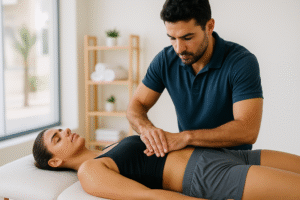
Myofascial Release Guide: Relieve Pain & Restore Mobility
Discover doctor-led myofascial release that targets fascia, eases chronic pain, and boosts flexibility. Personalized manual therapy restores natural movement.
Feeling unsteady on your feet can be more than just a physical issue; it can erode your confidence and limit your enjoyment of daily life. Whether you're a senior concerned about fall prevention, an athlete looking to enhance performance, or a patient recovering from a neurological event, mastering your stability is key to a full and active life. Effective balance and coordination training is not about performing a few generic exercises; it's a science-backed process that retrains your brain and body to work in harmony. At Physio Cure Dubai, we believe that reclaiming your stability starts with a deep understanding of your unique condition, which is why our doctor-led specialized neurological physiotherapy programs are designed to rebuild your confidence from the ground up.
Balance is a complex and seemingly automatic process, but it's actually an intricate symphony conducted by your central nervous system. To maintain your equilibrium, your brain constantly processes information from three critical sources. When we design a plan for balance therapy, we first identify which of these systems needs the most support. This is the essence of our root-cause diagnosis philosophy—we don’t just treat the unsteadiness; we pinpoint and correct the underlying system failure.
The three pillars of balance are:
A weakness in any one of these pillars can force the other two to work overtime, leading to fatigue and instability. A truly effective treatment plan, like the ones we create at Physio Cure, involves a comprehensive assessment to determine which systems are compromised and then develops a personalized regimen of exercises and therapies to strengthen and reintegrate them all.
In the world of physiotherapy, the expertise of your practitioner makes all the difference. At Physio Cure, we are proud to be "Dubai's Premier Doctor-Led Physiotherapy Clinic." This isn't just a tagline; it's the core of our treatment philosophy. Every single assessment, diagnosis, and treatment plan is managed and executed by a licensed practitioner holding a Doctor of Physical Therapy (DPT) degree. This ensures you are not just receiving exercises from a technician, but comprehensive care from a medical professional with advanced training in diagnosing complex musculoskeletal and neurological disorders.
Our commitment to 100% personalized care means we reject one-size-fits-all solutions. Your journey begins with a thorough initial assessment where we listen to your history, understand your lifestyle, and identify your specific goals. An athlete's balance program is fundamentally different from a senior's fall prevention balance exercises, and our team has the specialized expertise to design the perfect plan for you. Our collaborative team approach ensures you benefit from a wealth of experience:
This level of specialization, guided by our compassionate and highly qualified doctors of physiotherapy, ensures that your treatment plan is not only evidence-based but also perfectly aligned with your personal health journey.
Pro Tip: Consistency over intensity is key. Five to ten minutes of focused balance practice every day is far more effective for retraining your brain and body than one long, exhausting session per week.
The journey back to stability begins with mastering the basics. These foundational coordination exercises are designed to be safe, effective, and progressive. They target the core components of balance and can be modified to match your current ability level. Remember to perform these in a safe environment, with a sturdy chair or countertop nearby for support. The goal is to challenge yourself gently without risking a fall.
These exercises form the foundation of a solid balance program. As you grow stronger and more stable, a physical therapist can help you progress to more challenging and dynamic activities.
Once you've built a solid foundation, the next step in effective balance therapy is to introduce more complex and dynamic challenges. Our bodies don't operate in a static world; we need to be stable while walking, turning, carrying groceries, and reacting to unexpected bumps. This is where progression becomes critical. At Physio Cure, our patient journey is structured to move from simple stability to real-world functional strength.
Advancing your training involves several key principles:
For those looking to explore more advanced movements, resources from fitness experts can provide additional ideas to discuss with your physiotherapist. For instance, this guide on balance-improving exercises offers excellent examples of dynamic challenges that can be incorporated into a progressive program.
Effective balance therapy is a powerful blend of what you do (guided exercise) and what a skilled therapist does for you (hands-on manual therapy and advanced technology).
A truly comprehensive balance and coordination program goes beyond just exercises. At Physio Cure, our holistic and evidence-based approach recognizes that physical limitations can often be a barrier to successful balance training. Stiff joints, tight muscles, or nerve impingements can prevent you from getting into the correct positions to perform exercises effectively. This is where our hands-on expertise becomes invaluable.
Manual (Hands-On) Therapy is the cornerstone of our treatment. Before you even begin your exercises, our doctors may use skilled techniques to:
We complement our manual therapy with Advanced Technologies to accelerate your recovery. Our modern, clean, and well-equipped facility integrates modalities like:
This combination of personalized exercise, expert hands-on therapy, and modern technology ensures we are treating the entire person, not just the symptoms, leading to faster, more lasting results.
Ready to stop worrying about your stability and start living more confidently? Take the first step on your path to better balance. Contact Physio Cure Dubai today to schedule your comprehensive, doctor-led assessment and discover your personalized treatment plan.

Discover doctor-led myofascial release that targets fascia, eases chronic pain, and boosts flexibility. Personalized manual therapy restores natural movement.
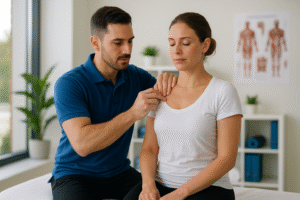
Learn how doctor-led trigger point therapy at Dubai’s leading clinic conquers chronic muscle knots, boosts mobility, and delivers lasting, root-cause pain relief.
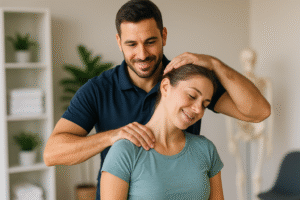
Discover how joint manipulation targets pain at its source, boosts mobility, and speeds recovery. Explore doctor-led physiotherapy for lasting relief.
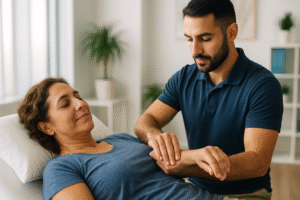
Discover doctor-led soft tissue mobilization that targets pain, breaks scar tissue, and restores full movement. Book evidence-based physiotherapy in Dubai.
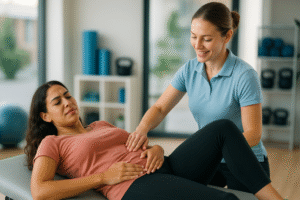
Endometriosis pain doesn’t have to rule your life. Physiotherapy targets root causes, releases pelvic tension, and restores comfort. Book a consult today.

Discover doctor-led physiotherapy for pregnancy lower back pain relief. Gain root diagnosis, customized exercises, and guidance for a pain-free journey.
Physio Cure Dubai, located in Dubai Silicon Oasis, offers a comprehensive range of physical therapy services. Our team of the best physiotherapists in Dubai are all real doctors providing personalized care, using the latest technologies and evidence-based techniques to help you, your child, and your loved ones recover and live a pain-free life.
DHA License No. 5411940
1510, SIT Tower, Dubai Silicon Oasis